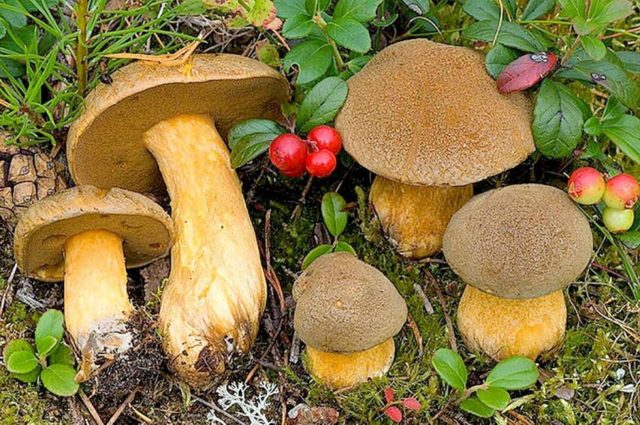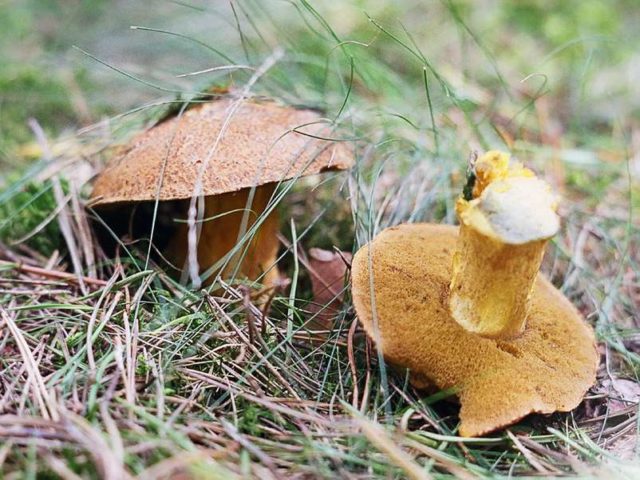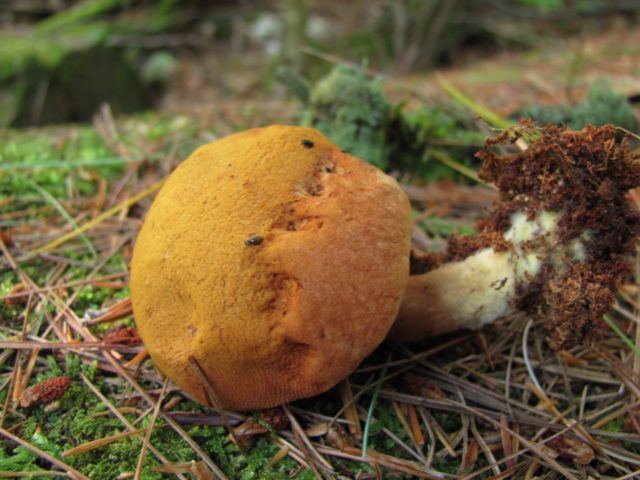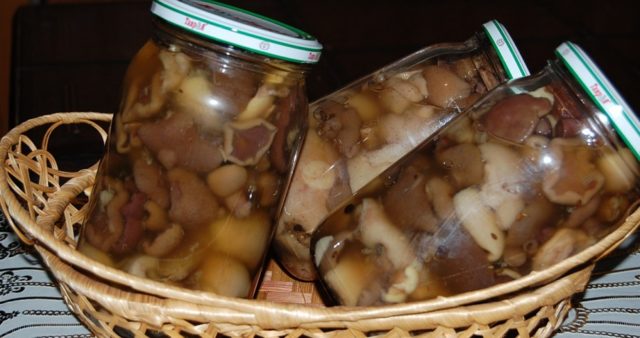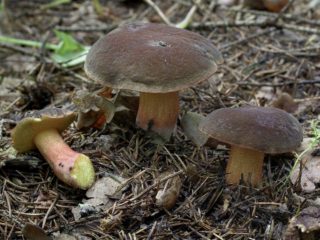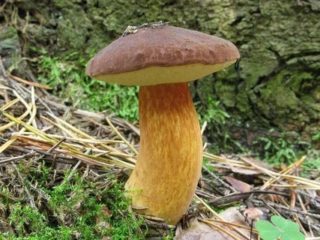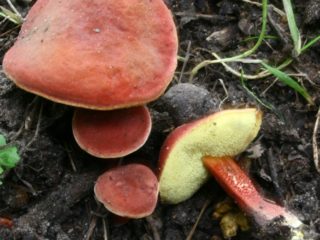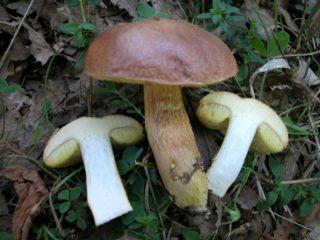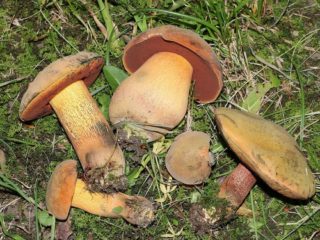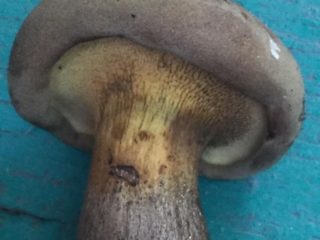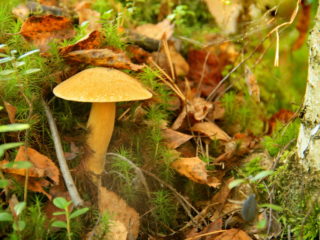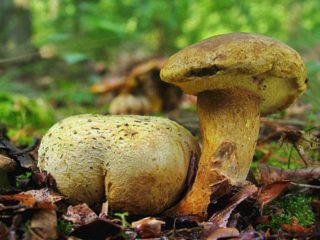Content
Flywheels of different types are popular representatives of the forest kingdom, from which many nutritious, tasty and healthy dishes with an amazing mushroom aroma are prepared. The yellow-brown flyworm grows in most Russian regions, belongs to the Boletov family, the Maslyat genus. This mushroom reveals its taste most fully in pickled form.
What does a yellow-brown flywheel look like?
According to the description, the yellow-brown flyworm (other names are variegated oiler, sandy or marsh flyworm, swamp) at a young age has a gray-orange cap color. As it ripens, the color becomes brownish, with a red tint, and subsequently acquires light, ocher tones. Young fruit bodies are distinguished by a semicircular cap, from 5 to 15 cm in diameter, the edges of which are bent downward, and its surface in young individuals is pubescent, gradually cracks and becomes covered with small scales, which, however, are not observed in older specimens. Often, with prolonged precipitation, mucus appears on the surface of the yellow-brown flywheel.
The bottom of the cap is completely dotted with the smallest tubes adhered to the stem. The color of the hymenophore is light orange, yellow, later - dark olive. The solid leg of the fungus has a clavate or cylindrical shape, in some cases it can be curved. It grows up to 9 cm in height and 3.5 cm in thickness. The color of the leg is yellow, lemon, at the bottom - with a reddish tint. Its surface is smooth; when broken in air, the pulp turns blue. The mushroom exudes the scent of pine needles. Raw pulp is tasteless.
Where does the yellow-brown flywheel grow
Yellow-brown moss grows on sandy soils in mixed and coniferous forests. They are found throughout the western part of Russia, in the Siberian and Caucasian regions. This mushroom is also well known in European countries. It can also be found in damp, swampy places covered with wet moss: the taste of such representatives is in many ways inferior to the yellow-brown flywheels growing in the forest. They like motley boletus to settle in small groups on peat bogs, interspersed with heather. Alone, these mushrooms are much less common. They bear fruit from mid-summer (July) to the end of September.
Useful video about yellow-brown flywheels:
Is it possible to eat a yellow-brown flywheel
Sandy Oiler is a Category 3 edible mushroom. Its taste is mediocre, but when pickled, they are fully revealed. Yellow-brown mushrooms are low in calories, which allows them to be widely used in dietary nutrition. And vegetarians value the high content of amino acids, comparable to meat, which makes these mushrooms a particularly valuable and useful product. The composition also contains vitamins - A, C, PP and D. As for vitamin D, its content in flywheels exceeds the amount of a similar substance in butter.Molybdenum, which is a rare and valuable trace element, but is present in sufficient quantities in yellow-brown flywheels, also brings great benefits to human health.
Like all other mushrooms, yellow-brown mushrooms contain quinine, which makes it difficult for the digestive organs to digest them. People with diseases of the gastrointestinal tract are not recommended to abuse them, and in the stage of exacerbation of chronic diseases, they should be completely excluded from the diet. Mushroom dishes are contraindicated for children under the age of 3 years and the elderly. Food poisoning is threatened by eating mushrooms collected near roadways or industrial enterprises, since they absorb all toxic substances.
False doubles
You can confuse this mushroom:
- With edible velvet flywheel, the color of the cap of which is dark or reddish-brown, and the surface is velvety, even wrinkled in adulthood. The species grows in deciduous and mixed forests, preferring to settle under beech, oak or spruce in large groups.
- Wood flywheel, the cap and leg of which have the same reddish-brown color, dense solid flesh. The fungus does not have a distinct odor and prefers to grow on stumps or soil covered with sawdust. Inedible. Rarely found in Russia, more often in Europe, in mixed pine forests.
Collection rules
Mushrooms are collected in dry weather in mixed and coniferous forests, where pine tree species prevail. Fruit bodies are cut off completely, bypassing overgrown, old specimens. Young ones, with a hat no more than 5 cm in diameter, are best suited for preparing delicious culinary dishes.
Use
In yellow-brown oil, the fruit bodies are completely consumed in food. Both the caps and the legs have firm flesh that is great for pickling and frying. Having brought mushrooms from the forest, they immediately begin to clean and remove debris. The peel is very difficult to separate from the pulp, so it is not peeled, but washed thoroughly. The fruiting bodies are preliminarily boiled for 15 - 20 minutes. in salted water. Then they are pickled or fried with onions.
The recipe for classic pickled mushrooms.
Ingredients:
- 1 kg of mushrooms;
- 1 tbsp. l. vinegar essence;
- 1 tbsp. l. not iodized salt;
- spices - a few cloves of garlic, cloves, peas, bay leaves.
Cooking algorithm:
- Too large fruit bodies are cut after preliminary cleaning.
- Boiled mushrooms are thrown into a colander so that all the water is glass.
- Prepare a marinade from the specified components (except for vinegar and garlic).
- Put mushrooms in the marinade, boil for 5 minutes, add vinegar.
- The mixture is packaged in sterilized jars, having previously put several cloves of garlic in each.
- Pour 1 tbsp on top. l. sunflower oil and close with plastic lids.
- After cooling, they are removed to the lower shelf of the refrigerator or to the basement.
You can store variegated boletus in dried form. To do this, small specimens are strung on a thin thread and suspended in a well-ventilated, sunny place for 20-30 days. Finished fruits do not break, differ in elasticity and strength. For winter use, variegated boletus can be frozen, having previously boiled them in the above way. Prepared fruit bodies are placed in disposable containers and placed in a freezer.
Conclusion
A yellow-brown flywheel or butter dish in its taste can hardly compete with mushrooms of the highest category. However, due to its widespread growth, it is quite popular with mushroom pickers, especially in the absence of other representatives in the forest.Very fragrant, with the smell of fresh pine needles and delicious if properly prepared, the variegated butter dish perfectly diversifies the summer and winter table, will be a good help during dietary and vegetarian meals.
